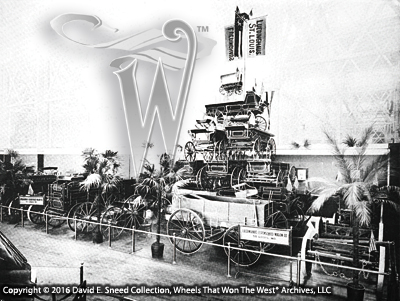Long before auto makers were showcasingtheir hottest concepts at car shows, the carriage and wagon industry was layingthe foundation for these head-turning events. In fact, even in the wildest days of the Old West, horse-drawn vehiclebuilders were displaying their most innovation and attractive creations. Many of these venues took place at highlypublicized gatherings such as local and state fairs as well as national andinternational expositions. Theatmosphere of these special events created tremendous opportunities for wagonand carriage makers to promote their wares to large crowds with a heightenedsense of excitement.
As the auto industry still does today,horse-drawn vehicle makers had several ways to set their products apart atthese shows. They jockeyed for prominentlocations, created impressive displays and signage, printed distinctive andcolorful support materials, worked to secure articles and editorial magazine features, and showcased unique vehicles that captured theintrigue and imagination of all who strolled by.
Among the more recognized show piecesthat collectors and enthusiasts may think of today is the giant farm wagonbuilt by the Moline Wagon Company for the 1904 World’s Fair in St. Louis(Louisiana Purchase Exposition). Duringthe same event, the legendary Luedinghaus-Espenschied Wagon Company took thetime to stack a number of their wagons. So effective was this massive pyramid that the image, itself, wastrademarked by the firm. Theaccompanying tagline touted the reputation and quality of the brand by stating,“We Tower Above All.”
 |
| This 1904 photo shows the ‘tower’ of vehiclesdisplayed by the Luedinghaus-Espenschied Wagon Company. |
At the 1893 Columbian Exposition in Chicago, Studebaker pulled out all the stops with a set of wheels often referred to as the ‘aluminum’ wagon. Itwas (and still is) an extraordinary piece to see. In fact, the showpiece cost them over $2,000to build – easily ten times the then-retail price of many farm wagons. At the time, aluminum was expensive anddifficult to work. Even so, in an effortto reflect their serious commitment to craftsmanship and innovation, Studebakerused the element to remove roughly two-thirds of the heaviest hardware andweight from a standard-sized farm wagon. Those efforts to lighten the design while keeping it strong meant thatthe vehicle could be moved with less effort while hauling more cargo. If all of this sounds familiar, itshould. Nearly one hundred twenty-five years afterStudebaker was the first to use aluminum in a vehicle, auto makers around theworld continue to work with this metal. Driving home that point, almost a year and a half ago, I wrote a blog onthe continued use of aluminum in some vehicles today.
 |
| This original Studebaker ‘Aluminum’ wagon is ondisplay at the Studebaker National Museum in South Bend, Indiana. |
Other well-known wagon companies withdisplays at the Columbian Exhibition included Kentucky, Mitchell, Jackson,Burg, Champion, Fish Bros., Milburn, Mitchell, Moline, Peter Schuttler, Stoughton,Weber, Keystone, Knickerbocker, Bettendorf, Armleder, Abresch, and many more.
Another rare exposition wagon that canstill be seen today is the Studebaker ‘Centennial’ wagon which was unveiled atthe first World’s Fair in Philadelphia in 1876. Celebrating the 100th anniversary of the signing of America’sDeclaration of Independence, this massive event is known as the CentennialExposition. The site, itself, is said tohave included more than 200 buildings spread out over several hundred acres. Lasting for six months, the event hosted morethan ten million visitors, including dignitaries from all over the world.
Among those with vehicles on display inthe Centennial's transportation section was a relatively small maker with big dreams. Hailing from Seymour, Indiana, Jacob Becker,Jr. unveiled an ornately crafted wagon with multiple patents protecting itsinnovative features. You can read moreabout this custom creation by checking out the exclusive story on our website.
 |
| Like the use of aluminum, the concepts of twin axlesteering and front wheel brakes seen here have also been incorporated intoautomobiles. |
There are a few other wagons I’ve comeacross in my research that may well have been used as a promotionalvehicle. That said, I’ve been unable toconfirm some of those suspicions with primary source documentation – at leastyet. As difficult as all of thisresearch is to complete, I’ve been a little more successful locating periodphotos of other pieces also shown at the Centennial event. One example is an original cabinet card wefound years ago. It features a patented crane neck dray built by John Beggs & Sons of Philadelphia. The photo below shows a portion of thatimage. Engineered to replace the morecommon two-wheeled drays of that time, the wagon is equipped with therelatively new-to-the-market Archibald wheel hubs. Established in 1839, the Beggs firm is saidto have been a significant producer of wagons for the Union Army during theCivil War.
 |
| Our efforts to learn more about this custom draybuilt by John Beggs & Sons also resulted in the discovery of extensive original color descriptions for the vehicle. |
 |
| With custom design elements and patriotic-themedcrests, this nineteenth-century wagon was likely built for a special event orpromotional show. Even so, we've yet to conclusively identify thisbuilder. |
Please Note: As with each of our blog writings, all imagery and text is copyrighted with All Rights Reserved. The material may not be broadcast, published, rewritten, or redistributed without prior written permission from David E. Sneed, Wheels That Won The West® Archives, LLC